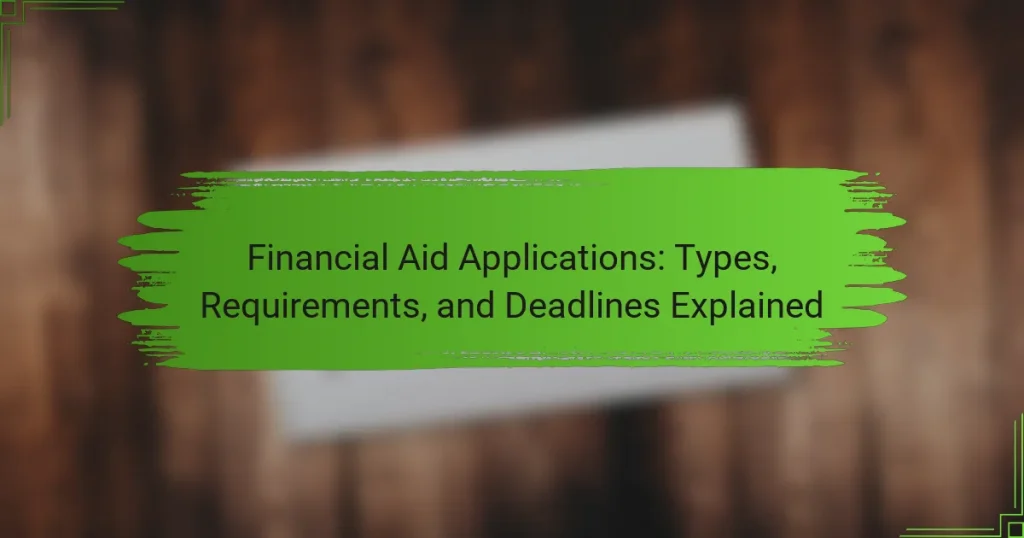
What are Financial Aid Applications?
Financial aid applications are formal requests submitted by students to receive financial assistance for education. These applications assess a student’s financial need and eligibility for various aid programs. Common types of financial aid include grants, scholarships, work-study, and loans. The Free Application for Federal Student Aid (FAFSA) is the most widely used form in the United States. Completing this application is essential for accessing federal and state aid. According to the U.S. Department of Education, over 13 million students complete the FAFSA annually. This process helps institutions determine the amount of aid a student qualifies for based on their financial situation.
How do Financial Aid Applications function?
Financial aid applications function by collecting financial information from students and their families. This process typically involves filling out standardized forms, such as the FAFSA in the United States. The information provided is used to determine the student’s eligibility for various types of financial aid. This includes grants, scholarships, and loans based on financial need and academic merit. Once submitted, the application is reviewed by financial aid offices at educational institutions. They assess the data to calculate the expected family contribution (EFC). The EFC is then used to determine the amount of aid a student may receive. Timely submission of applications is crucial, as many financial aid programs have deadlines. Statistics show that students who fill out financial aid applications are more likely to attend college.
What are the key components of Financial Aid Applications?
The key components of financial aid applications include personal information, financial information, and academic information. Personal information typically requires the applicant’s name, address, and Social Security number. Financial information includes details about income, assets, and family size. Academic information often consists of the applicant’s school, degree program, and enrollment status. These components help determine eligibility for various types of financial aid. For instance, the Free Application for Federal Student Aid (FAFSA) requires this information to assess a student’s financial need. Accurate and complete submissions are crucial for maximizing aid opportunities.
How do these components impact the application process?
The components of financial aid applications significantly impact the application process. They determine eligibility, required documentation, and deadlines. Each component, such as income verification, affects approval chances. Timely submission of documents influences funding availability. Different types of aid require specific information, which can complicate the process. Missing components can lead to delays in processing. Accurate information is crucial for avoiding rejection. Overall, these components shape the efficiency and success of obtaining financial aid.
What types of Financial Aid Applications are available?
The types of financial aid applications available include the Free Application for Federal Student Aid (FAFSA), the CSS Profile, and institutional applications. The FAFSA is essential for federal and state aid eligibility. It is used by colleges to determine financial need. The CSS Profile, created by the College Board, is required by some private colleges for non-federal financial aid. Institutional applications vary by college and may request additional financial information. Each application serves distinct purposes in the financial aid process. They collectively help students access various forms of financial support for education.
What are the differences between federal and state financial aid applications?
Federal financial aid applications primarily use the Free Application for Federal Student Aid (FAFSA). State financial aid applications vary by state and may have different forms or requirements. Federal aid is funded by the federal government, while state aid is funded by individual state governments. Federal aid often includes grants, loans, and work-study opportunities, while state aid may focus on grants and scholarships specific to residents. Deadlines for federal aid are generally set by the federal government, while state deadlines can vary significantly. Additionally, eligibility criteria for federal aid are standardized across the country, while state aid may have specific residency or academic requirements unique to each state.
How do institutional financial aid applications vary?
Institutional financial aid applications vary in format, requirements, and deadlines. Each institution may have its own specific application form. Some schools require the FAFSA, while others use their own forms or the CSS Profile. The information requested can differ significantly between institutions. For example, some may require detailed financial documentation, while others may focus on basic income information. Additionally, deadlines for submission can vary widely. Some schools have early deadlines for priority aid consideration. Variations reflect each institution’s policies and financial aid philosophy.
What are the common requirements for Financial Aid Applications?
Common requirements for financial aid applications include filling out the Free Application for Federal Student Aid (FAFSA). Applicants must provide personal information such as Social Security number and income details. They also need to list the schools they plan to attend. Many states require additional forms or information. Documentation of citizenship or eligible non-citizen status is necessary. Some institutions may request tax returns from previous years. Additionally, students may need to demonstrate financial need. Meeting deadlines is crucial for eligibility.
What documents are typically needed for submission?
Typically, financial aid applications require several key documents for submission. Commonly needed documents include the Free Application for Federal Student Aid (FAFSA) form. Applicants also need to provide their Social Security number. Tax returns from the previous year are usually required as well. Additionally, W-2 forms and other income documentation may be necessary. Some institutions request proof of citizenship or residency status. Furthermore, students may need to submit academic transcripts. Lastly, any additional forms specific to the institution or state may also be required. These documents collectively support the assessment of a student’s financial need.
How do eligibility criteria differ among various types of financial aid?
Eligibility criteria for financial aid vary significantly among different types. Grants typically require financial need, often assessed through the FAFSA. Scholarships may consider academic performance, extracurricular activities, or specific talents. Loans generally require a credit check, especially for private options. Work-study programs often prioritize students with financial need and enrollment status. Each type of aid has distinct requirements, reflecting its purpose and funding source. For instance, federal grants like Pell Grants focus on low-income students, while merit-based scholarships target high achievers. Understanding these differences is crucial for applicants to identify suitable aid options.
What are the important deadlines for Financial Aid Applications?
Important deadlines for financial aid applications vary by institution and type of aid. Typically, the Free Application for Federal Student Aid (FAFSA) opens on October 1 each year. Most states require FAFSA submissions by their deadlines, which can range from January to March. Colleges often have their own financial aid deadlines, commonly between February and April. Some states and institutions also offer priority deadlines for maximum aid consideration. For example, California’s FAFSA deadline is March 2. It is crucial to check specific deadlines for each institution to ensure eligibility for available aid.
How can students keep track of application deadlines?
Students can keep track of application deadlines by using a calendar or planner. Digital tools like Google Calendar can send reminders for upcoming deadlines. Setting alerts for specific dates helps ensure timely submissions. Creating a checklist of required documents aids in preparation. Regularly checking the financial aid office website provides updates on deadlines. Joining relevant social media groups can offer peer support and reminders. Utilizing mobile apps designed for deadline tracking can enhance organization. Maintaining a dedicated folder for application materials streamlines the process.
What are the consequences of missing financial aid application deadlines?
Missing financial aid application deadlines can result in losing eligibility for financial assistance. This can significantly impact a student’s ability to afford college. Without timely applications, students may miss out on grants, scholarships, and loans. Financial aid offices typically have strict deadlines. Late applications may not be considered, leading to reduced funding options. For example, federal aid programs require applications by specific dates. The Free Application for Federal Student Aid (FAFSA) has annual deadlines that vary by state. Missing these deadlines can limit financial resources available for tuition and fees. Ultimately, this can affect a student’s educational opportunities and financial stability.

How can students successfully navigate the Financial Aid Application process?
Students can successfully navigate the Financial Aid Application process by following a structured approach. First, they should gather necessary documents, such as tax returns and identification. Next, students must complete the Free Application for Federal Student Aid (FAFSA) accurately. They should pay attention to deadlines, as missing them can result in lost funding opportunities. Additionally, students can use online resources for guidance, including the Department of Education’s website. Seeking help from financial aid offices at schools can provide personalized assistance. Regularly checking application status is also essential to ensure all requirements are met. By staying organized and proactive, students can enhance their chances of receiving financial aid.
What tips can help improve the chances of receiving financial aid?
To improve the chances of receiving financial aid, applicants should complete the FAFSA accurately and on time. Submitting the Free Application for Federal Student Aid (FAFSA) is essential for accessing federal and state financial aid. Research indicates that students who file early have a better chance of receiving aid. Additionally, applicants should maintain a strong academic record. Many scholarships and grants consider GPA and test scores as eligibility criteria.
Building a compelling personal statement can also enhance an application. A well-written statement can showcase an applicant’s unique circumstances and goals. Furthermore, applicants should seek out multiple funding sources. This includes scholarships, grants, and work-study opportunities. Networking with school counselors can provide valuable insights into available aid options. Lastly, keeping documentation organized is crucial. Accurate records of income and expenses can streamline the application process.
How can students effectively organize their application materials?
Students can effectively organize their application materials by creating a structured system. They should categorize documents into sections such as transcripts, recommendation letters, and financial information. Utilizing digital tools like spreadsheets can help track deadlines and requirements. Setting up a checklist for each application ensures that nothing is overlooked. Regularly reviewing and updating the materials keeps them current. Additionally, using folders or binders can help physically separate different applications. This organized approach reduces stress and enhances the chances of completing applications accurately and on time.
What common mistakes should students avoid during the application process?
Students should avoid incomplete applications during the financial aid process. Many students fail to provide all required documents. This can lead to delays or denials of aid. Missing deadlines is another common mistake. Late submissions often result in lost funding opportunities. Additionally, students should not underestimate the importance of accurate information. Errors in personal details can cause significant issues. Failing to research available aid options can also be detrimental. Students may miss out on funding that suits their needs. Lastly, neglecting to follow up on the application status is a mistake. Regular checks can ensure that the process is on track and any issues are addressed promptly.
What resources are available for assistance with Financial Aid Applications?
Resources for assistance with Financial Aid Applications include government websites, educational institutions, and non-profit organizations. The Federal Student Aid website offers comprehensive information and guidance on financial aid. Colleges and universities often have financial aid offices that provide personalized assistance. Non-profit organizations, such as the College Board, offer tools and resources for navigating financial aid. Additionally, community workshops and online webinars can help students understand the application process. Many libraries also provide access to financial aid resources and workshops. These resources are designed to support students in completing their applications accurately and efficiently.
How can schools and community organizations provide support?
Schools and community organizations can provide support through workshops and informational sessions. These programs can educate students and families about financial aid options. They can also offer assistance with completing applications. Access to resources such as computers and internet can be provided. Collaboration with local financial aid experts can enhance the support offered. Additionally, schools can create mentorship programs to guide students through the process. Community organizations can connect families with scholarships and grants. Overall, these efforts can significantly improve access to financial aid for students.
What online tools can aid in the financial aid application process?
Online tools that can aid in the financial aid application process include FAFSA, CSS Profile, and scholarship search engines. FAFSA is the Free Application for Federal Student Aid, which is essential for federal financial aid eligibility. The CSS Profile is used by many private colleges to assess financial need. Scholarship search engines like Fastweb and Cappex help students find scholarships that match their profiles. These tools streamline the application process and provide access to various funding opportunities. They also offer guidance on completing applications correctly and meeting deadlines.

What are the potential outcomes of Financial Aid Applications?
Financial aid applications can result in several potential outcomes. The most common outcome is receiving financial aid, which may include grants, scholarships, or loans. Applicants may also be denied financial aid due to insufficient financial need or missing documentation. Additionally, some applicants may receive a reduced amount of aid based on their financial situation. In some cases, applicants may be placed on a waitlist for available funds. It is important to note that the outcome often depends on the applicant’s financial circumstances and the specific institution’s policies. For example, the U.S. Department of Education reported that in the 2020-2021 academic year, over 13 million students received federal student aid.
How are financial aid awards determined?
Financial aid awards are determined based on a student’s financial need, academic merit, and specific eligibility criteria. Financial need is assessed through the Free Application for Federal Student Aid (FAFSA) or similar forms. These applications evaluate family income, assets, and household size. The Expected Family Contribution (EFC) is calculated from this information. Schools use the EFC to determine the amount of aid a student qualifies for. Academic merit may also influence awards, including scholarships based on grades or test scores. Additionally, some awards may have specific eligibility requirements, such as enrollment in certain programs or attendance at specific institutions.
What factors influence the amount of aid received?
The amount of aid received is influenced by several key factors. These factors include financial need, which is assessed through income and asset information. Academic performance, including GPA and test scores, also plays a significant role. The type of institution attended can affect aid eligibility, as public and private schools may have different funding sources. Additionally, the cost of attendance at the chosen institution directly impacts the aid amount. Family circumstances, such as the number of dependents or unique hardships, can further influence aid decisions. Lastly, the availability of institutional funds and government grants can vary yearly, affecting the total aid disbursed.
How can students appeal financial aid decisions?
Students can appeal financial aid decisions by submitting a formal appeal letter to the financial aid office. This letter should clearly state the reasons for the appeal. Common reasons include changes in financial circumstances or errors in the original application. Students should include supporting documentation to validate their claims. Relevant documents may include tax returns, pay stubs, or medical bills. The appeal letter should be concise and professional. Students should follow up with the financial aid office to ensure the appeal is being reviewed. Many colleges have specific deadlines for appeals, so timely submission is crucial.
What should students do after receiving their financial aid award?
Students should review their financial aid award letter carefully. They need to understand the types of aid awarded, such as grants, loans, and scholarships. Next, students should accept or decline the offered aid through their school’s financial aid office. They must also meet any additional requirements, such as maintaining a certain GPA. Students should compare their financial aid with the total cost of attendance. This helps them determine if they need additional funding. Finally, they should keep track of deadlines for accepting aid and completing any necessary paperwork. Understanding these steps ensures students maximize their financial aid benefits.
How can students manage their financial aid effectively?
Students can manage their financial aid effectively by staying organized and informed. They should create a calendar for deadlines related to applications and renewals. Tracking all financial aid documents is essential to ensure nothing is missed. Regularly reviewing financial aid offers helps students understand their funding sources. Communicating with financial aid offices can clarify any uncertainties or issues. Utilizing budgeting tools can assist in managing funds received. Students should also explore scholarship opportunities to supplement their financial aid. Understanding the terms and conditions of their aid is crucial to avoid pitfalls.
What steps should students take if they need to reapply for aid?
Students should follow specific steps to reapply for aid. First, they need to check the deadlines for the aid application. Each institution may have different deadlines. Next, students should gather necessary financial documents. This typically includes tax returns and income statements. Students must then complete the financial aid application form. This could be the FAFSA or institutional forms. After submission, they should monitor their application status. Institutions may request additional information. Finally, students should review their aid offers once received. This ensures they understand the terms and conditions.
What are best practices for completing Financial Aid Applications?
To complete Financial Aid Applications effectively, gather all necessary documents beforehand. This includes tax returns, income statements, and Social Security numbers. Fill out the application accurately and honestly. Double-check all entries to avoid mistakes. Submit the application before the deadline to ensure eligibility for aid. Use the correct forms required by each institution. Seek assistance from financial aid offices if needed. Review application results and follow up on any additional requirements. These practices enhance the likelihood of receiving financial aid.
Financial aid applications are formal requests submitted by students to obtain financial assistance for their education, evaluating their financial need and eligibility for various aid programs such as grants, scholarships, work-study, and loans. The article outlines the key components of these applications, including personal, financial, and academic information, and discusses the differences between federal, state, and institutional applications. It emphasizes the importance of deadlines, common requirements, and strategies for successful navigation of the application process while highlighting potential outcomes and best practices for managing financial aid effectively.




